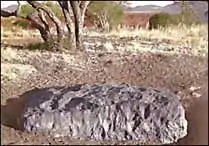Hoba meteorite
The Hoba[1] (/ˈhoʊbə/ HOH-bə) meteorite, short for Hoba West, is a meteorite that lies on the farm of the same name, not far from Grootfontein, in the Otjozondjupa Region of Namibia. It has been uncovered but, because of its large mass, has never been moved from where it fell. The main mass is estimated at more than 60 tonnes.[1] It is the largest known intact meteorite (as a single piece)[2] and about twice as massive as the largest fragment of either the Cape York meteorite's 31-tonne Ahnighito kept in Manhattan or the Campo del Cielo's 31-tonne Gancedo in Argentina. It is also the most massive naturally occurring piece of iron (actually ferronickel) known on Earth's surface. The name "Hoba" comes from Khoekhoegowab word meaning "gift".[3] It saw, on donation to the government, in 1987, its visitor centre's construction and its circular stone seating/steps area.
| Hoba | |
|---|---|
.jpg.webp) The meteorite in 2014 after becoming a tourist attraction | |
| Type | Iron |
| Class | 12 |
| Country | Namibia |
| Coordinates | 19°35′32″S 17°56′01″E |
| Fall date | Less than 80,000 years ago |
| Found date | 1920 |
Impact
The Hoba meteorite impact is thought to have occurred more recently than 80,000 years ago. It is inferred[4] that the Earth's atmosphere slowed the object in such a way that it impacted the surface at terminal velocity, thereby remaining intact and causing little excavation (expulsion of earth). Assuming a drag coefficient of about 1.3, the meteor appears to have slowed to about 720 miles per hour (0.32 km/s) from an entry speed to the atmosphere typically in excess of 10 km/s. The meteorite is unusual in that it is flat on both major surfaces.
Discovery
The Hoba meteorite left no preserved crater and its discovery was a chance event. In 1920,[1] the owner of the land, Jacobus Hermanus Brits, encountered the object while ploughing one of his fields with an ox. During this task, he heard a loud metallic scratching sound and the plough came to an abrupt halt. The obstruction was excavated, identified as a meteorite and described by Mr. Brits, whose report was published in 1920 and can be viewed at the Grootfontein Museum in Namibia.
Friedrich Wilhelm Kegel took the first published photograph of the Hoba meteorite.[5]
Description and composition
Hoba is a tabloid body of metal, measuring 2.7×2.7×0.9 metres (8.9×8.9×3.0 ft). In 1920 its mass was estimated at 66 tonnes. Erosion, scientific sampling and vandalism reduced its bulk over the years. The remaining mass is estimated at just over 60 tonnes. The meteorite is composed of about 84% iron and 16% nickel, with traces of cobalt. It is classified as an ataxite iron meteorite belonging to the nickel-rich chemical class IVB. A crust of iron hydroxides is locally present on the surface, owing to weathering.
Modern history
In an attempt to control vandalism, with permission from farm-owner Mrs. O. Scheel, the government of South West Africa (now Namibia) on March 15, 1955, declared the Hoba meteorite to be a national monument.[6] Since 1979 the proclamation has been extended to land of 425m².[7] In 1985 Rössing Uranium Ltd. donated to the Namibian government for more protection.
In 1987 farm-owner Mr. J. Engelbrecht donated the meteorite and the site where it lies to the state for educational purposes. Later that year, the government opened a tourist centre at the site.[7] As a result of these developments, vandalism of the Hoba meteorite has ceased and it is now visited by thousands of tourists every year. It can be seen from satellite imaging.
 The Hoba meteorite before the construction of the circular steps.
The Hoba meteorite before the construction of the circular steps. A woman sitting on the meteorite in 1967
A woman sitting on the meteorite in 1967.jpg.webp)
See also
| Wikimedia Commons has media related to Hoba meteorite. |
Notes and references
- Meteoritical Bulletin Database: Hoba
- McSween, Harry (1999). Meteorites and their parent planets (2nd ed.). Cambridge: Cambridge University Press. ISBN 0521583039. OCLC 39210190.
- Cassidy, Joseph (2009). Place Names of Namibia A Historical Dictionary. Windhoek: Macmillan Education Namibia Publishers (Pty) Ltd. p. 37. ISBN 978-99916-0-654-5.
- Field Guide to Meteors and Meteorites O. Richard Norton and Lawrence Chitwood. Springer Science + Business Media 2008, ISBN 978-1-84800-156-5
- Spencer, L. J.; Hey, M. H. (March 1932). "Hoba (South-West Africa), the largest known meteorite" (PDF). Mineralogical Magazine and Journal of the Mineralogical Society. XXIII (136): 4. Bibcode:1932MinM...23....1S. doi:10.1180/minmag.1932.023.136.03. Archived (PDF) from the original on 2016-12-15.
- Comerford, M.F. (September 1967). "Comparative erosion rates of stone and iron meteorites under small-particle bombardment". Geochimica et Cosmochimica Acta. Elsevier Science, New York. 31 (9): 1470. Bibcode:1967GeCoA..31.1457C. doi:10.1016/0016-7037(67)90021-X. ISSN 0016-7037.
- Voigt, Andreas (2004). National Monuments in Namibia: An Inventory of Proclaimed National Monuments in the Republic of Namibia. Gamsberg Macmillan. pp. 4–5. ISBN 9991605932.
Further reading
- Universe: The Definitive Visual Dictionary, Robert Dinwiddie, DK Adult Publishing, (2005), pg. 223.
- Spargo, P. E. (2008). "The History of the Hoba Meteorite Part I: Nature and Discovery" (PDF). Monthly Notes of the Astronomical Society of Southern Africa. 67 (5/6): 85–94. Bibcode:2008MNSSA..67...85S. Retrieved 2018-07-24.
- Spargo, P. E. (2008). "The History of the Hoba Meteorite Part II: The News Spreads" (PDF). Monthly Notes of the Astronomical Society of Southern Africa. 67 (9/10): 166–177. Bibcode:2008MNSSA..67..166S. Retrieved 2018-07-24.
- Spargo, P. E. (2008). "The History of the Hoba Meteorite Part III: Known and Loved by All" (PDF). Monthly Notes of the Astronomical Society of Southern Africa. 67 (11/12): 202–211. Bibcode:2008MNSSA..67..202S. Retrieved 2018-07-24.